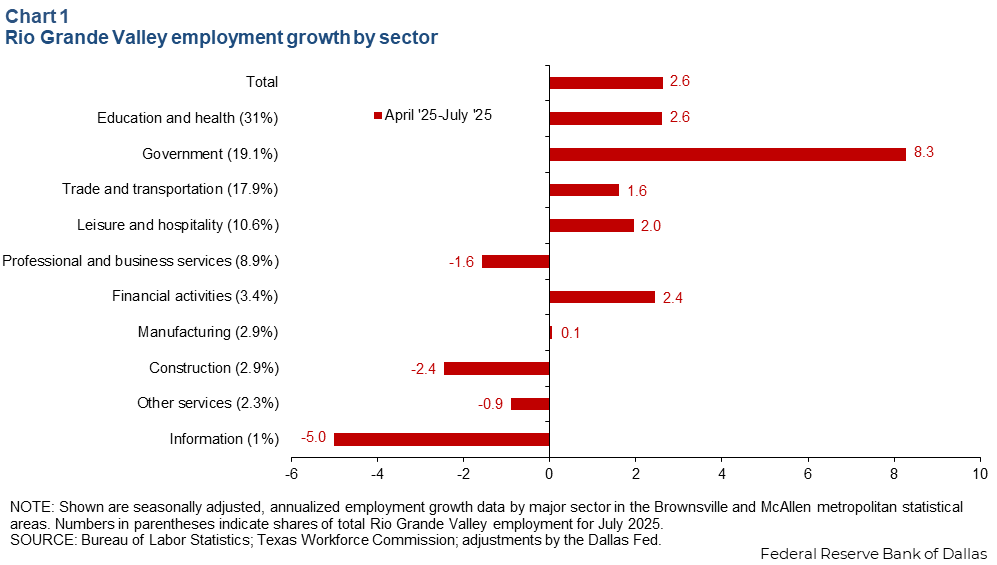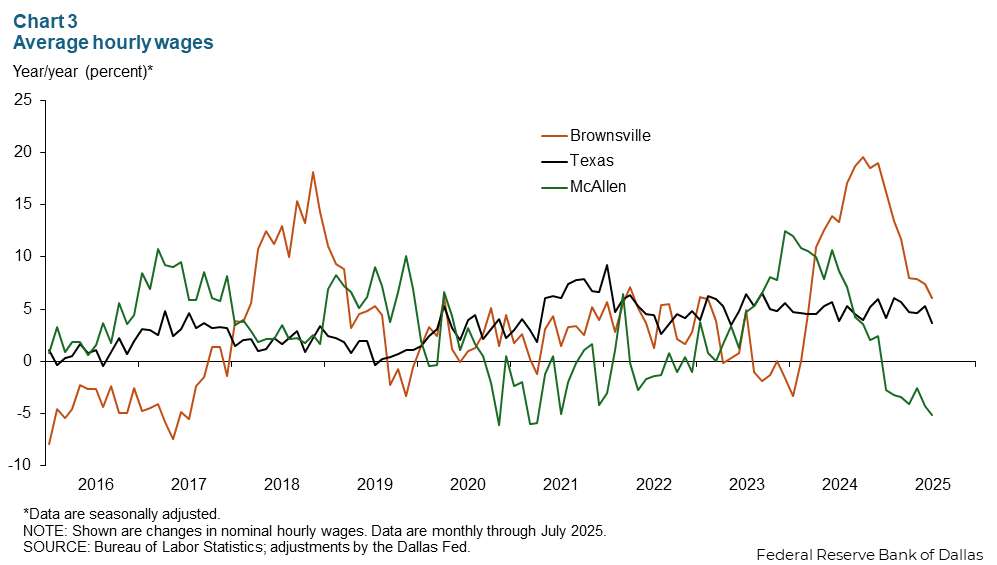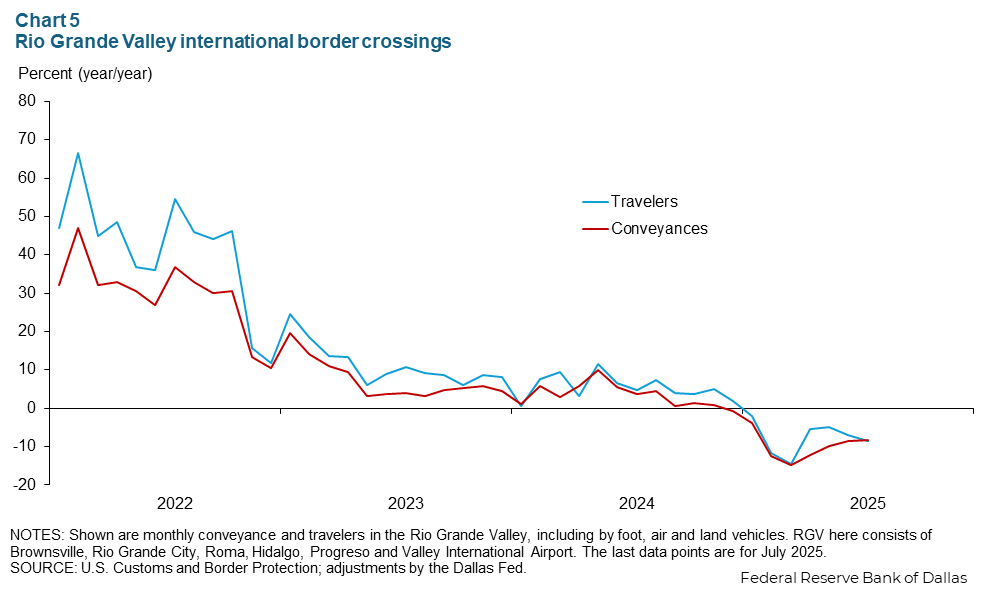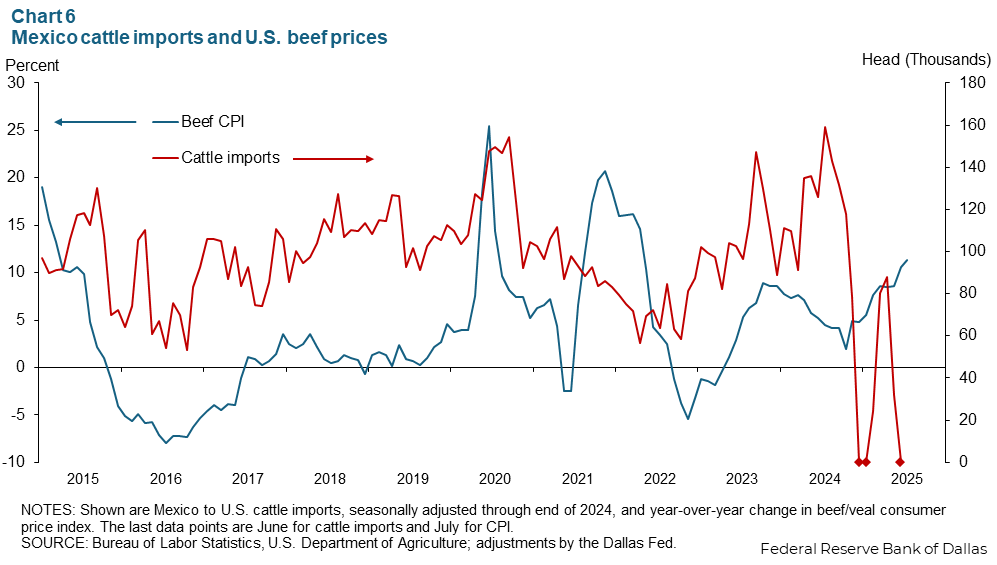Rio Grande Valley Economic Indicators

| Rio Grande Valley economy dashboard (July 2025) | ||||
| Job growth (annualized) April–July '25 |
Unemployment rate |
Avg. hourly earnings |
Avg. hourly earnings growth y/y |
|
| Rio Grande Valley | 2.6% | 6.4% | $21.00 | -1.7% |
| Brownsville | 3.0% | 6.9% | $21.57 | 6.1% |
| McAllen | 2.4% | 6.2% | $20.72 | -5.2% |
Expansion continued in the Rio Grande Valley. Employment grew, but unemployment rose. Year-over-year wage increases were mixed, with wages down in McAllen but up in Brownsville. Cross-border trade fell. Water storage in Rio Grande Valley reservoirs is rising, though it remains well below historical levels.
Labor market
Employment growth solid
Rio Grande Valley jobs increased an annualized 2.6 percent from April to July (3,000 jobs), faster than Texas (0.4 percent) and the U.S. (0.3 percent). Growth was mixed, led by government (1,800 jobs, or 8.3 percent), education and health (900 jobs, or 2.6 percent), trade and transportation (300 jobs, or 1.6 percent), and leisure and hospitality (200 jobs, or 2.0 percent) (Chart 1). Employment contracted in a few sectors, with the largest decline in professional and business services (200 jobs, or 1.6 percent).

Unemployment increases
Since the beginning of the year the unemployment rate in Brownsville has risen 1.8 percentage points, putting it above the jobless rate in McAllen for the first time in over a decade. In July, Brownsville unemployment remained elevated at 6.9 percent (Chart 2). Although Brownsville’s labor force expanded, the number of unemployed rose faster. Unemployment rates in both metro areas were higher than the jobless rates of 4.0 percent in Texas and 4.2 percent in the U.S. in July.

Wage growth mixed
Private sector hourly wages in Brownsville continued to rise. Wages were up 6.1 percent year over year in July, though the pace of growth is decelerating (Chart 3). Wages in McAllen were down 5.2 percent year over year and have been falling on a year-over-year basis since January. Wages rose 3.6 percent in Texas in July from year-earlier levels.

Water availability
Farmers and households alike in the Valley depend on river water. Water levels in Rio Grande Valley reservoirs rose to 26.2 percent of storage capacity in early August but remained 33.4 percentage points below their historical average (Chart 4). Mexico and the U.S. recently came to an agreement for Mexico to deliver more water to the U.S. this year. Though the speed of transfers has increased according to the International Boundary and Water Commission, it remains unclear whether Mexico will be able to make these deliveries by October.

Border activity
Border conveyances and travel decline
The movement of goods and people across the border in the Rio Grande Valley continued to decline in the second quarter of 2025. In July, conveyances were down 8.3 percent year over year, and the volume of travelers declined 8.6 percent (Chart 5). It is likely that trade uncertainty and tighter immigration policies are weighing on cross-border activity.

Cattle border closes due to screwworm
The New World Screwworm, a parasitic fly which feeds on animal flesh, was detected 370 miles south of the U.S. border. If the screwworm infected Texas cattle at a rate similar to the outbreak of the 1970s (20 percent), Texas could face economic losses of $1.8 billion. Texas is the leading producer of cattle in the U.S.
As a result, the U.S. closed the cattle border with Mexico for the second time since December 2024. Cattle imports dropped to zero in June (Chart 6). Historically, Mexican cattle imports have made up over half of U.S. cattle imports. These trade restrictions come at a time of high beef prices and solid domestic demand.

NOTES: Employment data are for the McAllen–Edinburg–Mission and Brownsville–Harlingen metropolitan statistical areas (Cameron and Hidalgo counties), unless otherwise specified. Data may not match previously published numbers due to revisions.
About Rio Grande Valley Economic Indicators
Questions or suggestions can be addressed to Ethan Dixon at Ethan.Dixon@dal.frb.org. Rio Grande Valley Indicators is published quarterly.